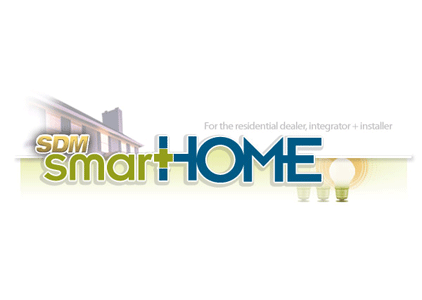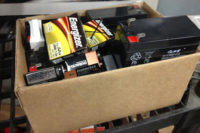 Many electronic system contractors (ESC) often know green as motorized shades, LED lighting and home energy management and monitoring. Courtney Baker sees a bigger green. “These are major areas that the dealer/installer community can affect; but being green is a lot more than just saving energy. It is also about indoor air quality, water efficiency indoor and outdoor, material selection and generally being aware of how [a client’s] home ‘should’ work.”
Many electronic system contractors (ESC) often know green as motorized shades, LED lighting and home energy management and monitoring. Courtney Baker sees a bigger green. “These are major areas that the dealer/installer community can affect; but being green is a lot more than just saving energy. It is also about indoor air quality, water efficiency indoor and outdoor, material selection and generally being aware of how [a client’s] home ‘should’ work.”
Michael Cogbill of ETC, a home technology firm in West Palm Beach, Fla., agrees that home tech professionals gain by looking beyond just electricity by adding water and gas into the green monitoring mix. “Water conservation is growingly important. But such monitoring also plays another role, alarming on something that might not be right with services to the home.”
Beyond security, today’s hot buttons often are entertainment systems and home systems integrated with mobile devices. But when it comes to selling green into the home, it all depends on an ESC’s base, business model and homeowner interest. “Homeowners do not, largely, seem interested,” observes Marilyn Sanford of La Scala Home Cinema + Integrated Media, Vancouver, Canada.
People find green tech and home energy management “interesting for a while. Then it is not interesting anymore. They want to be entertained and be safe and secure,” adds Gordon Van Zuiden of CyberManor, Los Gatos, Calif. He suggests that, with some green and sustainable solutions, there is no effective payback to save energy or money.
Sanford, in a way, concurs: “Once homeowners get feedback on [energy] usage, they are more likely to change their habits. However, ultimately this is not something that engages over the long term, as there is only so much they can do to impact their usage and change their behavior. Once they get the feedback and make changes, there is a narrow bandwidth of opportunity.”
Yet, with home energy management as with some other home systems, the desire by the homeowner to have mobile controls continues to impact. One change, Van Zuiden notes, is that “wall-mounted devices are disappearing, maybe one or two masters remain, with handhelds and mobiles replacing them.”
So when it comes to green, it’s a matter of educating clients as well as surviving the industry and economic shifts. “We need to lead and make this easy for the homeowner. However, I believe the last four years of market and technology shifts in our industry have diluted the interest, energy and overall commitment to green. I also think the consumer sees green as murky and difficult,’ says Sanford.
She’s got a point.
Amid a climate of economic uncertainty, Americans now place a higher value on their own financial stability over environmental responsibility. However, they are still looking to make sensible environmental choices, according to the latest Green Gauge U.S. Report from GfK Roper Consulting, a division of GfK Custom Research North America, New York City.
The research firm has been examining environmental attitudes and behaviors of consumers since 1992; and the most recent report found that 41 percent of Americans say, "First comes economic security, then we can worry about environmental problems.”
Green of Rich Green Design, Palo Alto, Calif., acknowledges impact of the economy on green initiatives and sustainability. “We are obviously recovering from the dip in new housing construction, so most of the action is in retrofit. Yes, there are still a few mega homes being built, and most of them, fortunately, have an eye toward energy management. Some are even conscious of sustainability in building materials and methods.”
Green adds that “in the retrofit space, however, it's difficult to add complex structures, so we are mostly seeing clever conversions of lighting and HVAC controls enabled by home networking technologies like ZigBee, PLC and Wi-Fi. I'm seeing solar thermal and photo voltaic systems in many new construction projects, usually integrating with energy dashboards, so the family can see the fruits of their conservation behaviors. It still freaks me out to hear about 35,000-square-foot homes, though. The future of sustainability is slow, small and analog. I might have a minority opinion about this, but from an anthropological point of view, ‘Small is Beautiful.’ The book by that title by E.F. Schumacher is brilliant and a must read for anyone embarking on a mega home project,” suggests Green.
Green teaches sustainability, is a member of the Custom Electronic Design & Installation Association (CEDIA) Advisory Board, and the founder and chair of the CEDIA Technology Council.
Home system professionals “should be addressing the energy efficiency of all consumer electronic products and how to manage phantom loads in the home. This could be done through selling smart power strips for home entertainment systems or integrating whole home energy monitoring devices,” says Courtney Baker, who worked in the residential systems integration industry and helped CEDIA with its Green Task Force. He currently works exclusively in sustainability.
“There is research that states homeowners who are aware of how much energy they are using (in real-time) tend to use less than a home that just typically receives a power bill at the end of the month. The decrease in usage varies from study to study and house to house, but it is typically three to seven percent,” says Baker.
Green agrees. “Most homeowners would love to reduce their energy bills and do the right thing. Integrating smart thermostats and whole house lighting controls are great steps in the right direction and easy to implement with non-invasive technologies that do not require new wiring or infrastructure. That's an easy sale.”
Green has taught a core curriculum that CEDIA offers. “It's [the curriculum] very practical. We show the math behind energy management systems in homes ranging from 2,500 square feet to the mega homes. Depending on local energy rates and access to tiered pricing, return on investment can be very convincing. Anyone selling into this space should take the time to master these courses and use the calculators we provide to show a homeowner exactly when their investment pays for itself,” Green advises.
In addition to getting homeowners on the green bandwagon, home builders and realtors are seeing growing business advantages in green concepts, home systems and energy management.
A survey of home builders found that over a fourth (27 percent) believes home technology greatly or somewhat increased their revenue in 2011. And when it comes to the sale of new and existing homes, a survey of realtors discovered that nearly two in ten (16 percent) handled a home with an energy management system last year, feeling the technology made for a quicker sale at a higher price. Check out this issue of smartHOME for more details on the home builder and realtor studies.
Energy management is just part of the green home story.
“Smart design goes way beyond lighting controls and thermostats. I think in terms of ‘sustainable lifestyles.’ Reducing energy consumption also includes adjustments to fundamental behaviors. We need to make it ‘stupid-easy’ for families to turn things off when they are not in use. There are all manner of clever power devices that respond to simple IP commands from mobile devices and Web interfaces. For several years now, we have been providing ‘hibernation scenes’ for families who leave their homes for extended periods, or for that kid's bedroom, usually chock full of electronics, when they leave for college,” says Green. “Kill all the vampire power suckers when they are not being used. That's integral to our designs now.”
Another aspect of design for sustainability, according to Green, “is use of low energy electronics in our designs. Advances in amplifier technology, for example, have given us really lean power amplifiers with efficiency approaching 90 percent. They sound excellent. There's no reason to specify power-hungry, fire-breathing electronics anymore. Same with TVs.”
Entertainment components and servers eat up a lot of energy. “I’ve heard that those combination cable box and DVR units use more electricity than a refrigerator,” says Luke Morton, sustainability manager at the architectural firm Fergus Garber Young, Palo Alto, Calif.
There is yet another interesting twist in this emerging green world. It’s called e-waste. Some homeowners find it inconvenient to dispose of their old gear from laptops and TVs to batteries and CFLs; some cities and states now mandate proper disposal of such gear.
Cogbill, for one, contacts his clients on a regular basis to pick up and properly dispose of the homeowner’s stuff, even including batteries, and at no cost. “We are now at the end of the cycle,” and the service is just one more way to connect to clients as part of the ongoing relationship.
Home appliances such as refrigerators, washing machines and dishwashers, beyond HVAC, are now slowly becoming part of a green home plan, first as part of some home energy management and control systems and then, thanks to communications abilities inside the appliances, part of a home network that also connects to the outside through the Internet.
“Fortunately, it's becoming easier to purchase energy efficient appliances because regulations steer manufacturers in the right direction. I just gave a talk for Marilyn Sanford. She produced a brilliant event for interior designers and custom home builders at the Sub-Zero/Wolf distributor's showroom” including integration with Control4. The technology is completely wireless and integrates with energy displays on TVs, touchscreens and mobile devices,” says Green.
“Lighting represents about five to 10 percent of overall energy in a home. Appliances and HVAC are where the money is. Shifting appliance use can be tough, as most consumers do not see a fridge or hot water tank as negotiable. Appliance automation will need to come into the mainstream for this. LED is a rising star, but fraught with issues because of the lack of standards for bulb specifications,” observes Sanford.
A lack of standards leads to the gray side of green.
It’s called greenwashing. A mashup of green and whitewash, environmental activists, at times too glibly, use it to label a form of corporate spin embedded in public relations or marketing to promote the perception that an organization's aims and policies are environmentally friendly.
Not a hard slog, it turns out. “There is really no definition of what’s green or not,” points out Morton. He says, however, that architects and the home building and remodeling industries — with the encouragement of groups such as Built Green, LEED and EarthAdvantage — are moving to measure it all “using metrics based on actual performance” of everything from construction techniques, building materials and HVAC to appliances, home controls and entertainment systems.
As with any emerging market opportunity, a green home takes at least two to tango.
“Sustainability is more about making wise decisions than spending big money. All you need is a human being with a conscience” or an interest in really saving resources, contends Green. “Control systems are dropping in price and smart electronics are ever more available. What's missing is good design, and this is where it really pays to train your staff in the techniques and mindset of sustainable lifestyles. CEDIA is right on top of this; there is great course content at EXPO this year.”
Local codes and incentives have, in some locales, encouraged homeowners to invest in various levels of green ranging from Energy Star appliances and home remodeling to more sophisticated systems and alternative energy sources. But, due to the economy, tight government budgets and politics, those incentives are diminishing while there is less enthusiasm for government involvement.
“California has an aggressive building code [encouraging] green standards…other areas such as Cincinnati have tax abatement programs that require green home certifications and can save homeowners thousands if not tens of thousands of dollars over a typical 15-year abatement,” says Baker. See this issue of smartHOME for an article further discussing homeowners’ needs for more incentives.
Speaking of drum beating, this month, the cable network HGTV kicks off its Green Home sweepstakes to give away an eco-friendly abode in an Atlanta suburb. See the article on the HGTV Green Home in this issue of smartHOME.
That could add some sheen to the green for ESCs.



